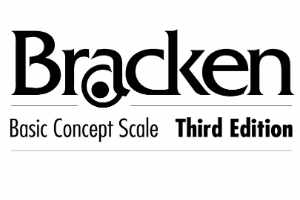Author:
Bruce A. Bracken, PhD
Overview:
Evaluate the acquisition of basic concepts of a child, which is strongly related to cognitive and language development as well as early childhood academic achievement
Age Range:
3:0 - 6:11 years
Scoring Option:
coring Assistant® software
RTI Tiers:
RTI Levels SRC - 1; Total Test - 2 and 3
Completion Time:
School Readiness Composite (SRC): 10-15 minutes. Receptive test total: 30-40 minutes.
Scores/Interpretation:
English: SRC and Subtest Scaled Scores, SRC and Total Composite Scores, Percentile Ranks, Concept Age Equivalents, and Descriptive Classification. Spanish: Percent Mastery
Report Options:
Teacher and Parent Reports
Publication Date:
Fall 2006
The Bracken Basic Concept Scale, Third Edition: Receptive (BBCS-3:R) and Bracken Basic Concept Scale: Expressive (BBCS:E) help you evaluate a child’s language skills, cognitive development, and school readiness. Together, these tools help assess a child’s basic concept skills receptively and expressively and compare results to national norms. Spanish-language adaptations of the record forms are available.
As a family of products in concept development, the Bracken assessments differ in focus and item type. In the BBCS-3:R, the child simply points to a correct picture. This is a nonverbal task. In the BBCS-E, the child verbally responds to stimulus items. The BSRA-3 is a school readiness screener; it evaluates just 5 areas of the full BBCS assessments. Together, they are a powerful set of tools for a child’s concept formation and academic success.
Uses & Applications
These instruments help you:
- Determine if the child has mastered the basic concepts needed to be successful in formal education
- Determine if a child has deficits in concept development that may need intervention
- Use results to plan intervention with the Bracken Concept Development Program
- Easily share results with parents and teachers
- Match to goals of state Early Childhood standards. These tests comply with No Child Left Behind and IDEA 2004 requirements
- Complete a discrepancy comparison to identify whether a child has a generalized concept deficit in both receptive and expressive skills or whether the deficit is primarily receptive or expressive
- Obtain criterion-referenced information for Spanish-speaking students using the Spanish adaptation of the Bracken Receptive and Bracken Expressive
Psychometric Information
- The standardization sample of 750 children is representative of the U. S. population and stratified by age, sex, race/ethnicity, geographic region, and primary caregiver education level.
- Test items were reviewed for content and cultural bias by a panel of speechlanguage pathologists and education specialists with expertise in assessment of diverse populations.
- All versions of the test have excellent psychometric characteristics, with extensive reliability and extensive validity evidence.
- The assessments include norms and clinical studies with children diagnosed with language impairments and children identified as having intellectual disability. Field research with Spanish adaptation was conducted in 2005 and 2006 to examine familiarity and appropriateness of the test items for Spanish-speaking children in the United States. A total of 61 Spanishspeaking children from the Midwest, South, and West participated in the study.
- Internal consistency reliability coefficients and an intercorrelation study with the English version demonstrate that the BBCS-3:R and BBCS:E reliably assess basic concepts. Evidence of validity based on test content and internal structure is presented.
Areas of Assessment
Evaluate and teach basic concept categories that are essential aspect of a child’s developing awareness of the world:
- Color
- Letters/Sounds
- Numbers/Counting
- Sizes/Comparisons
- Shapes
- Direction/Position
- Self-/Social Awareness
- Texture/Material
- Quantity
- Time/Sequence
These categories are essential aspects of a child’s developing awareness of the world. For example, the Colors subtest assesses children’s ability to identify and name 1) Primary Colors, 2) Secondary Colors, and 3) Color Absolutes (i.e., white and black). These colors are universal to all cultures and all languages and are necessary for describing the world in which we live. In addition, the concepts provide the building blocks for academic instruction. The Letters/Sounds subtest, for example, was developmentally sequenced to assess identification and naming of upper-case and lower-case letters.
Questions
Frequently asked questions follow. Click on a question to see the response.
-
My understanding of a confidence interval was that it was equal on both sides of a child’s standard score (i.e., plus or minus x). But I’ve just administered a Bracken where a child 3;11 achieved a raw score of 21 for his SRC, corresponding to a standard score of 88. With a 95% confidence interval it says the range is 80 to 98. By my calculation that makes it 8 points on one side and ten points on the other side. How is this possible?





